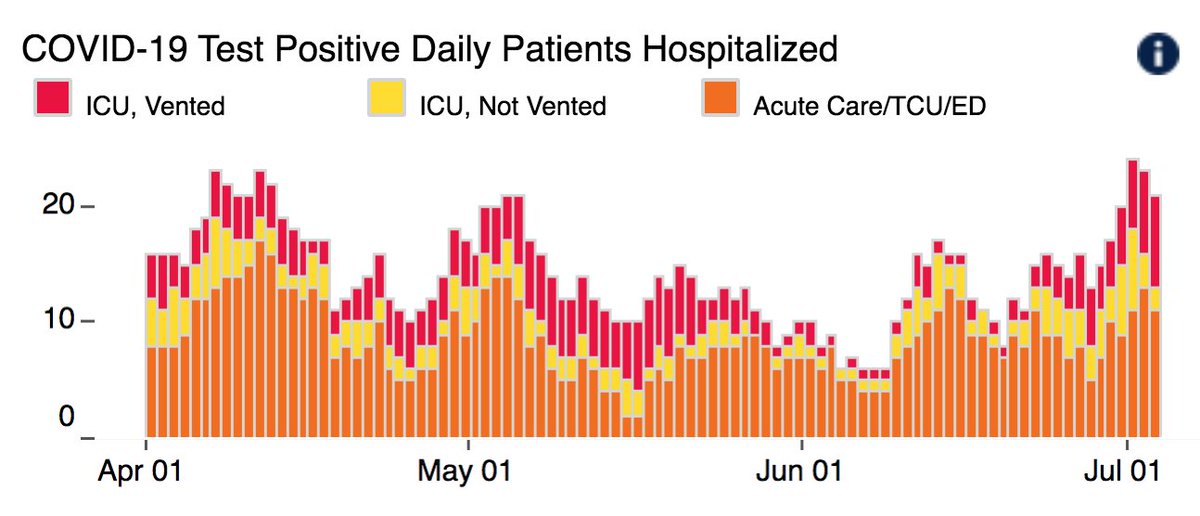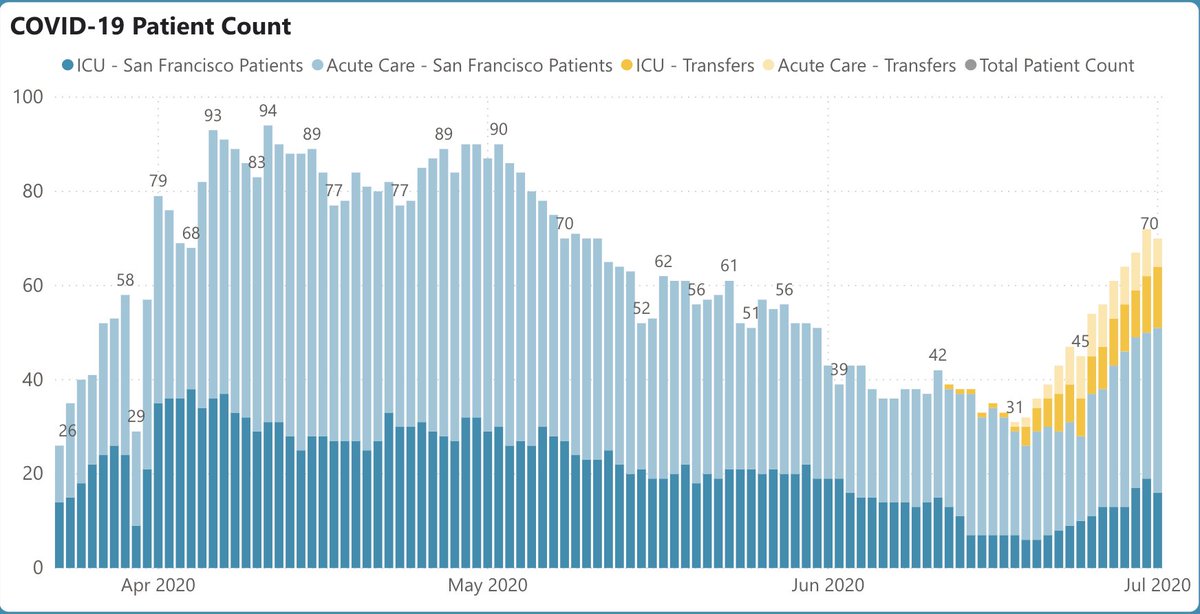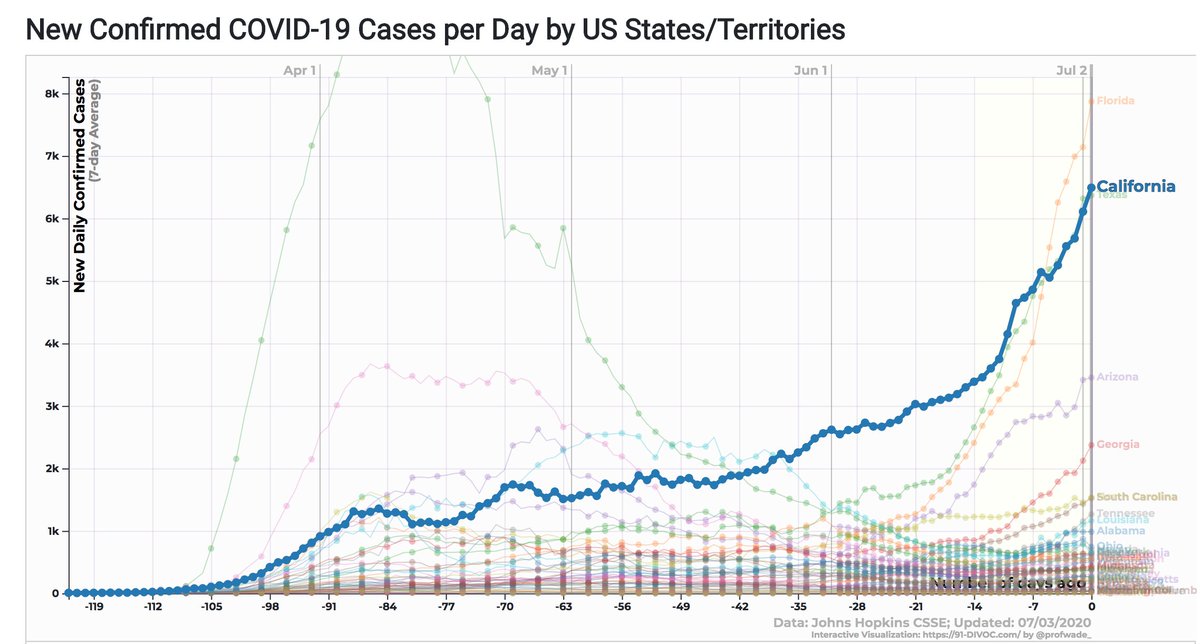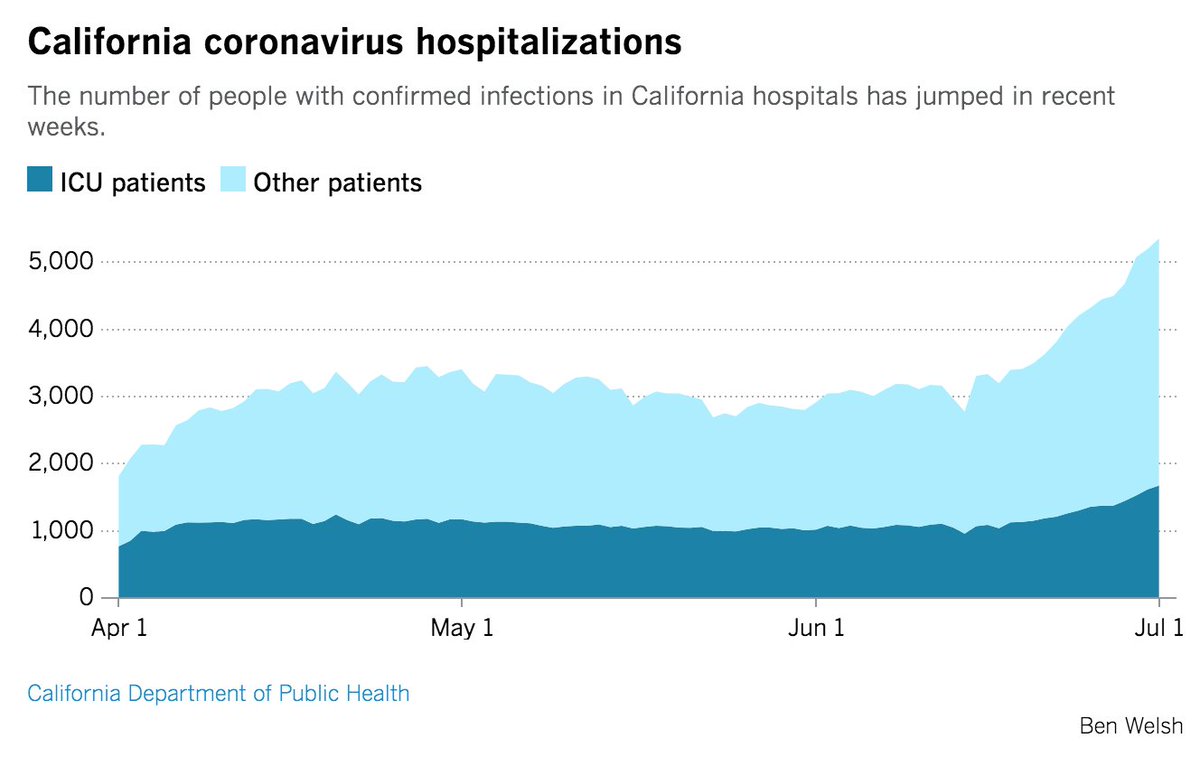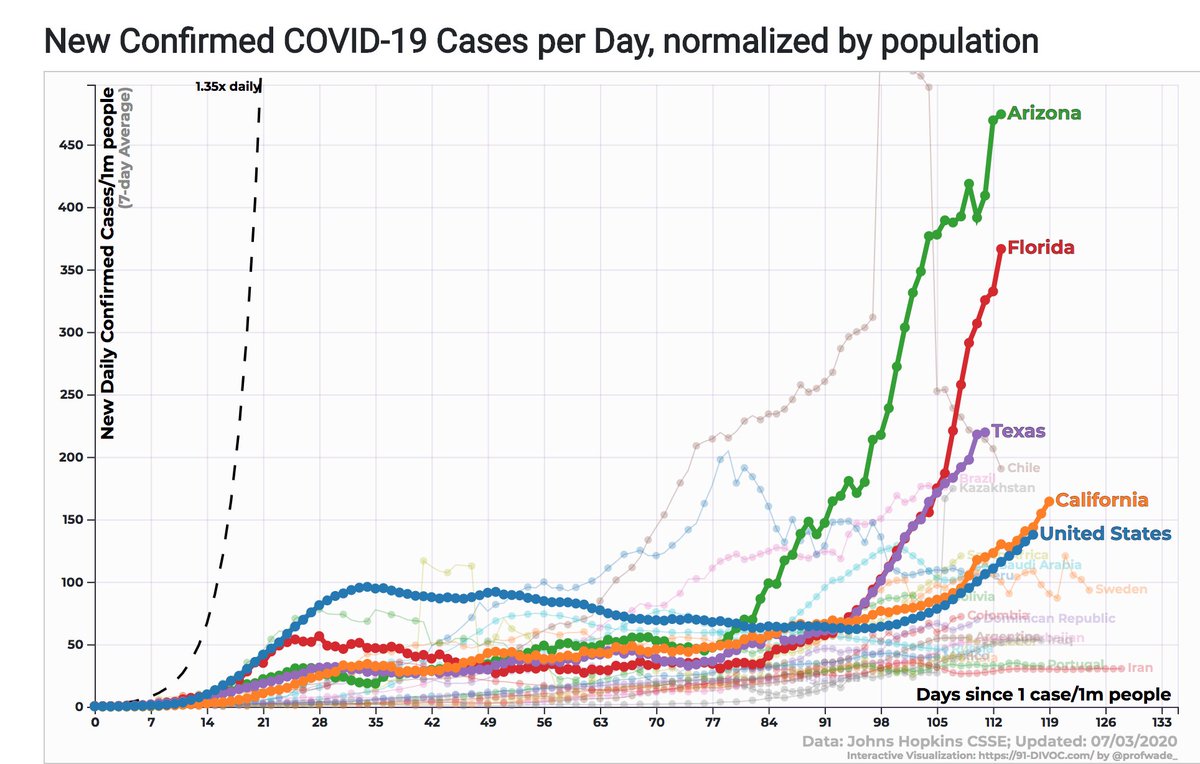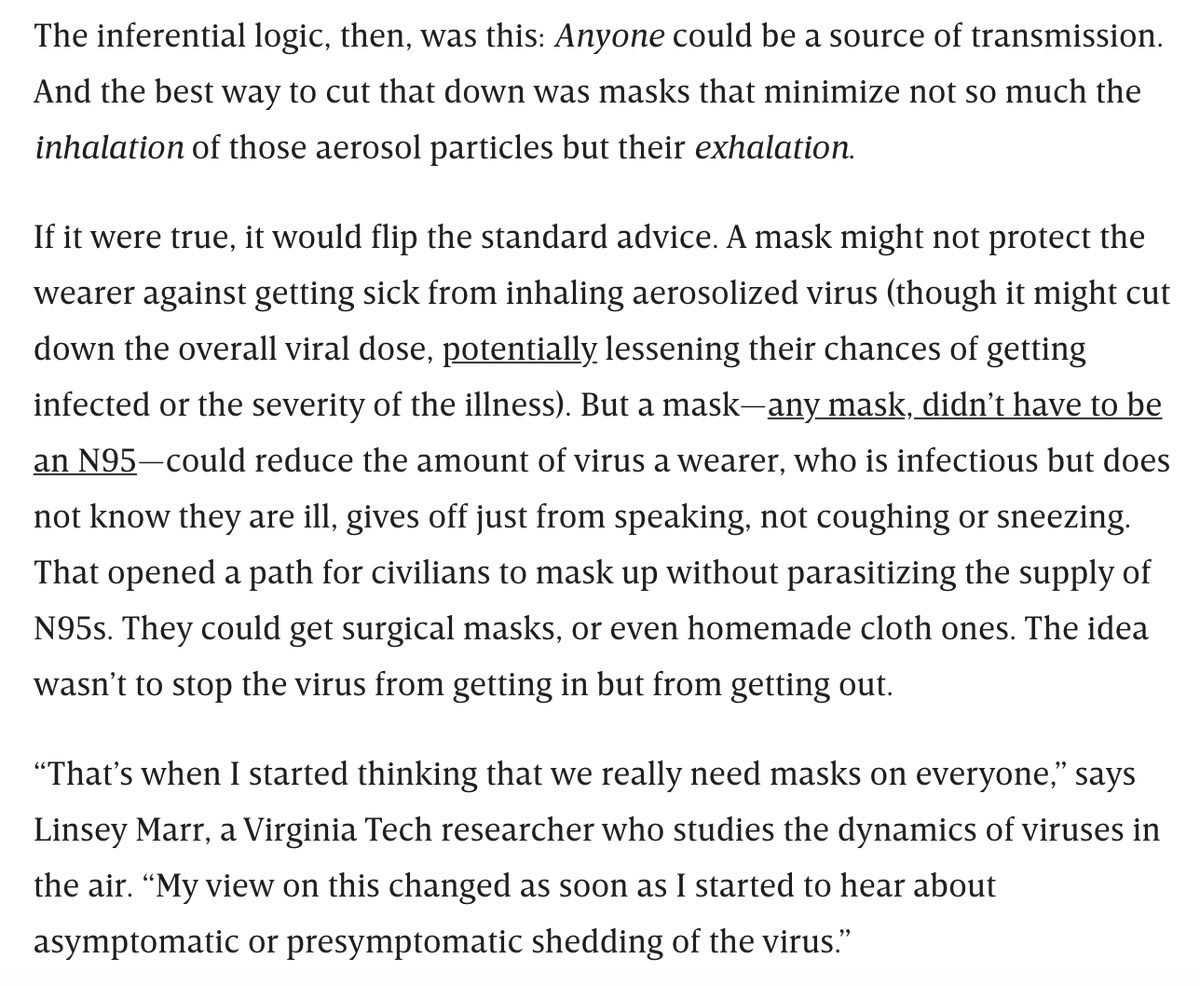1/ Covid ( @UCSF) Chronicles, Day 108
I’ve done a ton of media in past few days (eg, @NPR: https://n.pr/3inIcfK ) re: how CA fell off the rails. As I’ve thought hard about that, my answer is different from the one I would have given a few weeks ago. That’s today’s theme.
I’ve done a ton of media in past few days (eg, @NPR: https://n.pr/3inIcfK ) re: how CA fell off the rails. As I’ve thought hard about that, my answer is different from the one I would have given a few weeks ago. That’s today’s theme.
2/ First, the # ‘s. At @UCSFHospitals, 21 pts, 8 on vents, 2x early June (Fig on L). In SF: cases mildly up (43/d), hospital pts 70 (from ~30 two wks ago); but half the bump is from out-of-SF transfers (Fig R). So SF getting worse but I wouldn't call it “surge,” at least not yet.
3/ In CA, though, surge is an apt term, w/ >7K new cases yesterday (vs. ~2500 new cases/d in early June), hospitalizations up 56% in last 2 weeks (now 5200 hospitalized pts in CA) (Figs L & R). Test positivity rate up to 6.9%, from ~4.5% two weeks ago. All bad and scary numbers.
4/ What went wrong? The response by politicians in many states & by Trump & team leave much to critique. But, as I said last week https://bit.ly/3irx8Ot , CA’s surge is hard to pin on bad governance. CA has had strong leadership, & made reasonable decisions re: when/what to open.
5/ Important to add that governance and public attitudes DO matter – surges in AZ (2.8x that of CA, per capita), FL (2.2x), and TX (1.3x) are significantly larger than CA’s. Still, CA's surge is real, hospital & ICU numbers are up, and the death rate will inevitably climb soon.
6/ I’m increasingly viewing this surge (in CA & partly elsewhere) as a failure to turn masking & distancing into norms: acts that are admired & that – when not followed – lead to social/peer pressure to conform. There’s a science behind doing this, but it's barely been mentioned.
7/ We reviewed the evidence on masks and how we mucked up the messaging in Feb-Apr. Here’s my earlier review of the science & politics of masks https://bit.ly/2U7fHZ2 & some fine recent pieces that give the history, including yesterday's @nytimes op-ed https://nyti.ms/2D4rsK9 ...
8/ … and this @WIRED piece https://bit.ly/3gtp7XL , which highlights a pitched battle in the obscure field of aerosol science over droplets vs. aerosolized transmission…
(Talk about how many viral particles can dance on the head of a pin!)
(Talk about how many viral particles can dance on the head of a pin!)
9/ The early debate over the value of masks in Covid, along with efforts to preserve masks for healthcare workers, led to mixed messages. This left space for masks to be politicized, a mistake we've not recovered from.
10/ As these evidence reviews ( https://bit.ly/3iotxkx & https://bit.ly/3fLlj4r ) make clear, the debate is pretty well settled. Experts now agree on the value of masks – and yet many people choose not to wear them. This is sad and dangerous – they’re benign, cheap and effective.
11/ “But I heard in March that I didn’t need to wear them,” is a lame argument. I’ve yet to hear an ICU patient say, “I don’t want remdesivir or dexamethasone because 3 months ago you told me you weren’t sure they worked.” Science evolves, and reasonable people evolve with it.
12/ But here’s the point that's been underemphasized: it’s hard to get people to be vigilant for months, particularly when the per-exposure risk is fairly low, the unpleasantness of wearing a mask is constant, and the consequences of failing to adhere are not immediately visible.
13/ This is a familiar challenge in a field I’ve studied for 20 yrs: patient safety (preventing medical errors). Many of the things we ask healthcare workers to do (eg, cleaning hands to prevent infections; also using surgical checklists, performing double checks) are a pain…
14/ … and the bad outcomes are unusual and may be delayed. I’ve heard surgeons push back on using surgical checklists, saying, “I’ve never operated on the wrong body part!” Interestingly, I’ve never heard that from a surgeon after she or he HAS operated on the wrong body part.
15/ UK psychologist James Reason, the father of error analysis, once wrote, “If eternal vigilance is the price of liberty, then chronic unease is the price of safety.” It’s easy to be vigilant for a few weeks, but keeping it up for months is tough, and people fall off the wagon.
16/ When looking at today’s surging states, the popular narrative emphasizes their Redness (CA is the notable exception). But one can also make a case that it is states that dodged the first bullet & whose people – particularly ones at low personal risk from Covid – got fatigued.
17/ If our patience really lasts ~3 months, I fear we’ll see outbreaks in the Northeast in the fall, when memories of March/April fade. I hope not, and the many people w/ antibodies may mitigate it a bit, but this new phase may be a harbinger of a deadly game of Covid ping pong.
18/ Another lesson from industrial safety: over time, people begin taking short-cuts. And if they get away with them, they cheat more. This was the lesson of the Challenger Disaster, described by sociologist Diane Vaughan as “the normalization of deviance.” https://amzn.to/3ioyh9P
19/ Since letting down one’s guard is human, one needs a systematic way to fight it. One might think that the trick is a rule: you MUST wear a mask. But as we’ve seen, unless you’re prepared to fine or jail millions of people https://cnn.it/3eXQatR , you won’t get widespread use.
20/ Can a democratic, individualistic society get people to reliably wear masks and take other measures without oppressive rules or returning to lock-down? Yes, but we need a different tack: one focusing on normalizing the desired behavior & (gently) stigmatizing non-adherence.
21/ I’ve heard talk of “mask shaming.” That’s may be what we need. Smoking at parties used to be normative – until a combo of rules, evidence (particularly re: 2nd hand smoke), and campaigns made it decidedly uncool. Now, in many parts of the U.S., it would be shocking to see.
22/ Perhaps seeing Michael Jordan, Springsteen, and Michelle Obama in masks would help… or whoever it is that 25-year-olds find cool and persuasive (clearly, I don’t know). It can be done: in Japan and other Asian countries, masks have become normalized https://bit.ly/2ZAzH8n
23/ This isn’t easy. Messaging, particularly to young folks, will have to be tested to see what works: appeals to keeping themselves safe, to do the right thing, to saving grandma’s life…? Between Madison Avenue, Silicon Valley, & Hollywood, we should be able to figure this out.
24/ When I take Newman for a walk, I bring a leash and a poop bag – it's reflexive. And now, I also wear a mask. It not only demonstrates my concern for others (and for me & my family), it also makes me feel good. And I worry that I’ll be judged if I don’t. We need more of this.
25/ So let’s think more about sociology, psychology, & marketing – not just policy and politics. We must turn doing the right thing into expected behavior.
Back next Thursday for Grand Rounds: we’ll talk surges, schools, & San Quentin outbreak. Have a great and safe 4th.
Back next Thursday for Grand Rounds: we’ll talk surges, schools, & San Quentin outbreak. Have a great and safe 4th.

 Read on Twitter
Read on Twitter